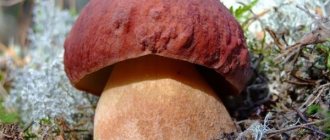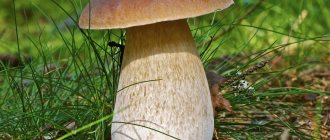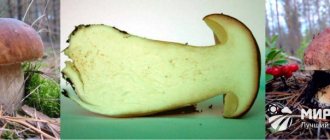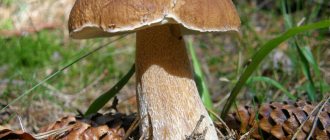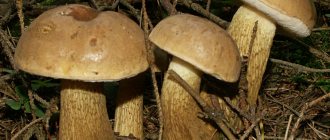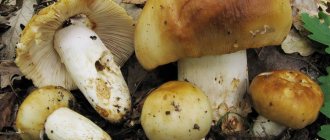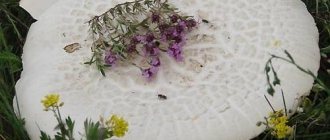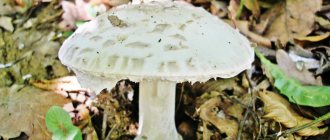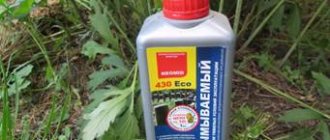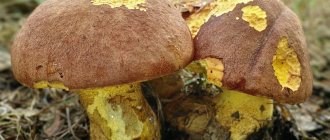The porcini mushroom (lat. Boletus edulis) represents the most respected mushroom genus - boletus. If earlier he was called the “king of mushrooms,” today we can say about him that he is the undisputed leader of the mushroom rating. This hero has unparalleled taste. It is difficult to confuse the porcini mushroom with its doubles and inedible analogues - it is so beautiful and unique. Boletus is the most desired trophy of a mushroom picker.
Features of porcini mushroom
Any type of boletus has a special mushroom aroma and piquant taste. They all have similar shapes, the differences are only in small details. Description of the external data of the most common variety of boletus - spruce (Boletus edulis):
- Hat . Color – brownish-brown. Diameter up to 30 cm. In some latitudes they can grow up to 50 cm. The upper skin is tightly adherent to the pulp. In drought it cracks, in rain it becomes covered with mucus.
- Leg. Thick, massive, up to 20 cm high. Thick – up to 5 cm. Shape – cylindrical or club-shaped. Expands towards the base. Color – white, light brown. There is a mesh pattern on the leg. Deeply buried in the soil. There are no traces of a blanket on the leg - boletus mushrooms do not have a “skirt”, the leg is perfectly clean.
- Pulp. In mature individuals it differs in density. Very juicy, white, fleshy, arouses appetite just by its appearance. When overripe, it has a fibrous structure and the color becomes yellowish or beige.
- Tubular body. First white, then yellowish. Older specimens have a greenish appearance.
- Controversy. Olive-brown powder. Size – 15.5 x 5.5 microns.
To determine the age of the mushroom, examine the cap - in young people it is convex, in old people it is flat. With age, its color darkens. Old mushrooms are not suitable for food.
The taste of boletus mushrooms is characterized by the softness of the pulp and the delicacy of the aroma. Heat treatment and drying only enhance the taste.
When and where does it grow?
The distribution range of boletus mushrooms is amazing - they are found on almost all continents. The exceptions are Antarctica and Australia. Japan, Mexico, Mongolia, North Africa, the Caucasus - boletus grows everywhere. You won't find it except in Iceland. In Russia it grows almost everywhere - from the southern latitudes to Kamchatka. The spruce boletus is found in spruce and fir forests.
Each area has its own fruiting time. In warm zones, the mushroom begins to grow in May-June, and bears fruit until October-November. In the north, the growth period is from June to September. It has a long growth phase - it needs to grow for a whole week to reach maturity. Grows in families, rings. Having discovered one specimen, you need to carefully explore the nearby space - there will probably be several more there.
Prefers to grow in forests:
- conifers;
- deciduous;
- mixed.
It grows most often under spruce, fir, pine, oak and birch trees. Where to look for them:
- in places overgrown with lichen and moss;
- loves old forests;
- It can grow in the shade, but the sun doesn’t bother it either – it prefers warm areas.
It doesn't grow:
- in wetlands;
- in peat bogs.
The best weather for massive growth of boletus mushrooms is passing thunderstorms, warm nights and fogs.
Rarely found in forest-tundra and steppe. His favorite soils:
- sandy;
- sandy loam;
- loamy.
Mushroom pickers tell how to find boletus mushrooms in forest-steppe conditions. They will reveal to you the secrets of mass collection, and where porcini mushrooms are hidden:
Planting mycelium
An alternative method is to plant a “seedling”, which is a fragment of a mycelium dug in the forest.
A shaded area is selected for the landing site, like the boletus mushroom in the photo. On it, about a month before the planned planting, you need to dig a hole 25-35 cm deep and about 2 m wide, which will immediately have to be filled with a nutrient mixture. The mixture is made from fallen oak leaves collected in the spring, rotted oak wood and clean manure (preferably horse manure). The leaves are laid in layers of about 20 cm, between which thin layers of wood and manure are made. The hole filled in this way should be poured with a one percent solution of ammonium nitrate, and after a week it should be completely shoveled, forming a homogeneous mass.
At the time of planting the mycelium, the mixture is removed from the hole and laid in layers of no more than 12 cm, sprinkled with a slightly thinner layer of ordinary soil. Fragments of mycelium are planted in a checkerboard pattern at a distance of at least 30 cm from each other. (When the mushrooms sprout, you will get excellent pictures of boletus if you photograph the bed)
As for the planting material itself, it is prepared in the form of layers of soil, carefully cut around the above-ground part of the porcini mushroom. Having cut out a block of earth measuring approximately 30x15x15 cm, it needs to be divided into several fragments, which are laid at the planting site to a depth of about 7 cm.
After planting the mycelium, the bed is slightly moistened and covered with foliage, which will retain moisture.
Varieties
Boletus mushrooms grow everywhere in the forests of Russia, and there are a great variety of them. It is clear that they are all from the same family. They are distinguished only by the nuances of their appearance. All belong to the first taste category, each has an inedible double. Therefore, when starting a “silent hunt”, carefully study the external signs of those mushrooms that are found in your area.
Pine
Its external characteristics practically repeat the general description of boletus mushrooms. What are the differences:
- The cap is red-brown with a diameter of 8-25 cm. Shade – purple.
- Pulp. Under the skin it is pink.
- The leg is very thick, short - up to 15 cm. On top there is a light brown mesh.
- The thickness of the tubular body is 2 cm. The shade is yellowish.
It has an early form, characterized by a lighter cap and flesh. Growth begins at the end of spring and continues until October. It settles under pine trees - hence the name. With them it forms mycorrhiza - a fungal root. Found on sandstones, alone and in families. Distribution area: Europe, America, the European part of Russia.
Birch
Its second name is spikelet. It is collected when earing of rye fields begins. Distinctive features:
- The hat is light yellow, with a diameter of 5-15 cm. The flesh does not have a distinct taste. It does not darken at the break.
- The leg is barrel-shaped, with a light mesh.
- The thickness of the tubular layer is 2.5 cm. The shade is yellowish.
Prefers to grow under birch trees. They grow singly and in groups. Favorite places are on the edges, near roads. Distribution area: Western Europe, Siberia, Far East. Collection season is June-October.
Dark bronze
Hornbeam or copper. Species differences:
- Round, fleshy cap with a diameter of 7-17 cm. Dark shades. It may be covered with cracks.
- The pulp is white. With a pleasant aroma and taste. In the rift the color changes.
- It is distinguished by a massive leg - it is pinkish-brown. Covered with brown mesh.
- A tubular layer 2 cm thick. Yellow in color, turns green when pressed.
Fans of edible delicacies value hornbeam boletus more than the “classic” porcini mushroom (spruce).
Grows in deciduous forests in warm climates. Distribution: Europe, North America.
Other varieties
There are also the following varieties of porcini mushroom:
- Reticulate. It has a brownish or light ocher cap. The leg is short, cylindrical in shape. Can be confused with moss fly. Prefers beeches and hornbeams. Grows in Europe, North Africa and North America. It has a pronounced mesh on the leg. Fruiting time is June-September. Rarely seen.
- Oak. The hat is grayish in color. Sometimes there are light spots on it. It differs from other boletus mushrooms in its more loose pulp. Prefers oak groves. Habitat: Caucasus, Primorsky Territory. It has a brown cap, very similar to the gall mushroom.
- Semi-white mushroom. The color of the cap is light brown or clayey. The flesh is dense and smells like carbolic acid. Distribution area: Carpathian region, Polesie, southern Russia. There is no mesh pattern on the leg. The hat is light brown.
White mushroom reticulate
White oak mushroom
Semi-white type of porcini mushroom
Collection rules
It is quite difficult to make a mistake when collecting boletus mushrooms. All poisonous representatives of this family have a characteristic color with red tones, which makes the likelihood of error quite low. However, during a “silent hunt” you should adhere to generally accepted rules:
- You should not take mushrooms unless you are absolutely sure that they are edible and safe.
- During the growth process, fruiting bodies literally absorb radionuclides, heavy metal salts, and other harmful substances. They should not be collected in close proximity to busy highways or railroads, or at abandoned military or industrial sites where they usually grow in abundance.
- When picking mushrooms, you need to cut them with a knife, and not pull them out of the ground, otherwise the mycelium threads will be destroyed.
- Boletuses almost always grow in groups. Often the mycelium stretches along natural folds of the terrain: ditch, ravine, old automobile track. It is in this direction that the search needs to continue.
- It is better to immediately leave wormy specimens in the forest by pinning them on a tree branch. Ripe spores spill out of the cap and form a new mycelium. And the dried mushroom will be eaten by birds or squirrels.
- Boletus mushrooms with a small number of worms inside can be used for processing, for example, they can be dried. However, the harvest must be processed immediately upon returning from the forest, otherwise the larvae will not only continue to destroy the wormy mushrooms, but will also crawl onto neighboring, clean ones.
By adhering to these simple rules of “quiet hunting”, you can be confident in your health and safety.
Who can be confused with?
Boletus mushroom is usually confused with gall fungus (false boletus mushroom). Signs by which they can be recognized:
- According to the color of the cut. In the gall fungus, the flesh becomes dark, acquiring a pinkish-brown color. The porcini mushroom has white flesh and does not change color.
- The stem of the gall mushroom has a bright pinkish mesh; in a real boletus it is white or yellow.
- The gall mushroom is bitter. The bitterness does not disappear even after cooking. But during pickling, if you add vinegar, it decreases.
Gall mushroom (gorchak) is a poisonous false porcini mushroom.
The porcini mushroom has another double - the satanic mushroom. But with it, confusion occurs less often. Experienced mushroom pickers immediately see the difference, and it is significant:
- The color of the cap of the double is whitish to olive-gray.
- The flesh at the break immediately becomes reddish or bluish.
- The leg is covered with a mesh pattern. Its color is the main sign of a satanic mushroom. It is red-yellow on top, red-orange in the middle, and yellow-brown below. It's hard not to notice the difference!
Poisonous twin of boletus - satanic mushroom
The value and benefits of the mushroom
Boletus is the most valuable food product. The calorie content of raw boletus is 22 kcal per 100 g. Ingredients:
- proteins – 3.1 g;
- carbohydrates – 3.3 g;
- fats – 0.3 g;
- dietary fiber – 1 g;
- water – 92.45 g;
- ash – 0.85 g.
Boletus mushrooms are simply a storehouse of all possible vitamins, minerals and other useful substances. This is a valuable product that combines taste and beneficial properties. Porcini mushrooms contain everything the body needs, including:
- Selenium. There is so much of it in the pulp that consumption of mushrooms can resist cancer in the early stages.
- Ascorbic acid – normalizes the functioning of all organs.
- Calcium, iron, phosphorus and other vital elements.
- Phytohormones – eliminate inflammation.
- B vitamins - strengthen the nervous system, help normalize energy metabolism, improve memory and sleep, prevent infections, increase mood and appetite.
- Riboflavin – normalizes the functioning of the thyroid gland, promotes hair and nail growth.
- Lecithin is useful for patients with atherosclerosis and anemia. Clears blood vessels of cholesterol.
- B-glucan is an antioxidant that protects the immune system, saves the body from fungi, viruses, and bacteria.
- Ergothioneine - renews cells, restores the liver and kidneys, is beneficial to the bone marrow, improves vision.
Harm
Boletus mushrooms contain chitin, which is difficult to digest. It can damage:
- children;
- pregnant women;
- people with kidney disease and gastrointestinal diseases.
Porcini mushrooms are capable of absorbing harmful substances from the environment. Do not collect them near businesses and industrial areas.
Boletus spores, like other mushrooms, can cause negative reactions in allergy sufferers. The main danger is eating its double - the gall fungus. Therefore, you need to carefully study the signs of this inedible species.
How to collect
To collect real edible porcini mushrooms, you must adhere to certain rules:
- The best time to collect them: warm and humid weather without sharp temperature fluctuations.
- It is better to collect boletus mushrooms early in the morning, then juicy, wet mushrooms will be stored longer.
- You should not go out to pick mushrooms in dry weather. Dry air “pulls” moisture from the pulp and leads to an increase in the concentration of harmful substances in it.
- You need to collect mushrooms only in ecologically clean areas: away from industrial zones, highways, railways, landfills, wastewater treatment plants, fields, pastures and livestock farms.
- No need to take wormy mushrooms. The waste products left by worms in the pulp are almost impossible to wash or clean out, so they can cause poisoning.
- You should not collect large boletus mushrooms. Large size is a sign of maturity: the older the mushroom, the more toxic substances accumulate in it.
In addition to your own safety, you need to collect mushrooms in such a way as not to harm nature:
- in order not to damage the mycelium, the find from the mycelium must be unscrewed or cut off;
- If the mushroom turns out to be wormy or overripe, it should not be thrown on the ground. It would be better to hang it on a small branch with the tubular layer down. This way, spores will spill out onto the soil, and its dried pulp can be used as food for forest animals in the cold season;
- Poisonous mushrooms cannot be destroyed, since they are a necessary link in the forest ecosystem.
When going to the forest, you need to take care of the surrounding nature: the forest is home to a large number of living creatures.
Use in food
Porcini mushroom is a low-calorie food product. Suitable for cooking, frying, drying, stewing, pickling. The cooked pulp is tender and has a mushroom smell.
Eating porcini mushrooms in dried form allows the body to absorb up to 80% of proteins. Nutritionists advise eating dried boletus mushrooms.
Dried porcini mushrooms have the strongest aroma, dried using the correct technology - it is important that the pulp loses moisture gradually. Mushrooms are considered a difficult food to digest. But it is dried boletus mushrooms that are the most easily digestible mushroom product.
Appearance
Porcini mushrooms are characterized by their large size, massive caps of a pleasant brown hue, and light roundish legs. There are real record holders among them.
Large white mushroom
Interesting fact : records for the size of mushrooms have been repeatedly recorded. In 1961, a mushroom weighing over 10 kg with a cap of 58 cm was found. In 1964, the second largest boletus was recorded, which weighed almost 7 kg.
Growing
Porcini mushroom, despite its unsurpassed taste, is not grown on an industrial scale - it is unprofitable. Usually, amateur gardeners are engaged in cultivation. There must be coniferous or deciduous trees on the personal plot. There should be no fruit trees, cultivated shrubs or vegetables nearby. The most difficult thing in growing boletus is creating conditions for the successful creation of connections between tree roots and mycelium.
It is desirable that the site is adjacent to the forest. If this is not possible, you need to have at least a few pine, aspen, birch, oak or spruce trees on your future “plantation.” Trees on the site must be at least 8 years old. There are two ways to grow porcini mushrooms – from mycelium and from caps.
Growing from mycelium
Cultivation begins with the purchase of planting material. You need to buy mycelium in specialized stores. Next, prepare the area and plant the mycelium:
- The soil is exposed near the trunks. The top layer is removed - approximately 20 cm. The diameter of the circle should be approximately 1-1.5 m. The removed soil is saved - it will be needed to cover the crops.
- A layer of peat is applied to the area prepared for planting. Rotted compost can be used. The fertile layer should not be thicker than 2-3 cm.
- Mycelium is placed on top. The interval between adjacent pieces is approximately 30 cm. The pieces are laid out in a checkerboard pattern.
- The mycelium is covered with previously removed soil. Water generously. You need to pour about 3 buckets of water under one tree. Pour carefully so that the soil does not erode.
- Next, mulch the watered soil with straw. The thickness of the layer is 30 cm. This is done to maintain the required humidity - so that the mycelium does not dry out. Crops need to be watered weekly. Be sure to add nutritious fertilizer to the water.
Before frost, areas with mushrooms are covered. For insulation you can use moss, spruce spruce branches, fallen leaves. With the arrival of spring, the insulation is raked using a rake.
A year will pass and the first fungi will be removed. If you properly care for the mycelium, water and feed it on time, the mushroom “plantation” will bear fruit for up to 5 years.
Growing from caps
To implement this method, you will need to get a few mushroom caps. Find mature, or better yet, overripe boletus mushrooms in the forest. The diameter of the cap should be at least 10 cm. It is best that when broken, the cap has a greenish tint - this indicates the maturity of the spores.
When collecting caps, you need to remember what trees the mushrooms grew under. It will be necessary to sow spores under the same trees. If a boletus is found under a spruce, it is unlikely that it will take root under a birch or aspen.
The procedure for preparing the site and planting seed:
- About a dozen caps are soaked in a bucket of water. It is advisable that the water be rainwater. Add one thing per 10 liters:
- alcohol – 3-5 tbsp. l.;
or sugar – 15-20 g.
- After 24 hours, you should mash the boletus caps. Knead until you get a mass similar to jelly. After straining it through cheesecloth, the water is separated from the mushroom tissue with spores.
- Prepare a place for planting - exactly as in the previous version. But be sure to water peat or compost with tannins for disinfection. To prepare the solution take:
- black tea – 100 g;
or oak bark - 30 g.
- Next, they begin planting - water containing boletus spores is poured onto the prepared fertile layer. The solution is stirred while pouring. The crushed caps are placed on top, the planting is covered with previously removed soil, and covered with straw.
Mushrooms should be soaked no later than 10 hours after collection - otherwise they will spoil.
Tea is brewed in 1 liter of boiling water. The second option is to boil oak bark for 1 hour. Water the soil with the cooled solution - 3 liters for each tree.
Boletus mushrooms can reach a yield of up to 250 kg per 1 hectare. Under each tree, during the season, you can collect a bucket of porcini mushrooms.
All that remains is to take care of the crops - water them regularly, sparing no water. If the soil dries out, the mycelium will die before it has time to germinate. For the winter, the area is insulated with spruce branches or leaves. In the spring - they rake. The first mushrooms will appear next summer or autumn.
Growing indoors
You can grow boletus indoors:
- First, the premises are sterilized with a 1% chlorine solution - it kills mold and parasites.
- Creates warm and humid conditions. Place barrels of water or put wet sawdust.
- Prepare a substrate with mycelium. They put it in bags. They make cuts.
- The bags are placed at intervals of 5 cm.
- The temperature is maintained at +23-25 °C, no more. Excess will destroy mycelium.
Boletus deservedly received its royal status - it surpasses all known mushrooms in taste and health. If it is not possible to find a sufficient number of boletus mushrooms in nature, they can be grown artificially.
0
0
Copy link
We plant boletus with spores (seeds)
Ripe wild mushrooms are used as planting material. Wormy and dried specimens will do just fine. You can determine the appropriate mushroom by breaking the flesh of the cap. If it has a slightly greenish tint, it means the mushroom is ripe for planting.
As follows from the amateur photos and descriptions of boletus, the caps must be thoroughly kneaded until smooth to release as many spores as possible, and soaked in a weak solution of potassium permanganate (1 gram per bucket). You should also add a little sugar (5-6 tablespoons) to the water, which will create a nutritious environment. In this form, the mushrooms should stand for several hours, preferably a day.
In the meantime, we are preparing the landing site. It should be about a meter away from the tree, but in a place where many of its roots pass through. Trying not to damage the root system, you need to remove about 15 cm of the top layer of soil. Planting material is poured directly onto the roots at the rate of 300-400 g. for 20-30 sq. cm. Then the planting site is covered with loosened soil and watered abundantly. If the soil in the area itself is wet, 5-6 buckets of water during planting will be enough. If the area is moderately dry, the planting site needs to be watered periodically, but not very abundantly. Simply moistening the surface layer will be enough. If you overdo it with watering, the spores will simply be washed away from the roots, so when watering it is recommended to pour water on the tree trunk.
to sow boletus at the end of summer, or at the beginning of September, which coincides with the natural cycle of these mushrooms.
